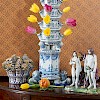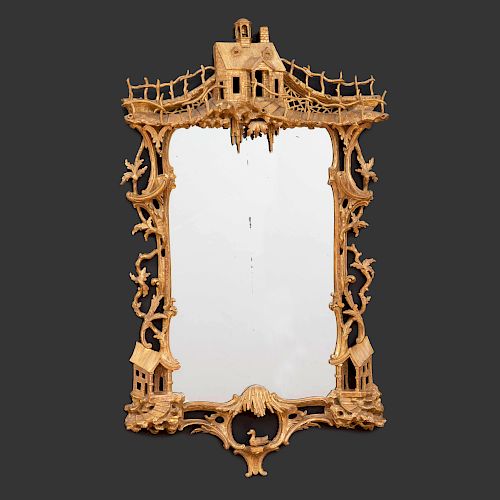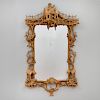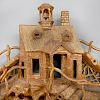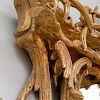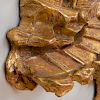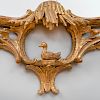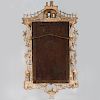Extraordinarily Fine and Unusual George III Giltwood Mirror, in the Manner of Thomas Johnson
Bid Increments
| Price | Bid Increment |
|---|---|
| $0 | $25 |
| $200 | $50 |
| $500 | $100 |
| $3,000 | $250 |
| $5,000 | $500 |
| $10,000 | $1,000 |
| $30,000 | $2,500 |
| $100,000 | $5,000 |
The rectangular mirror plate surmounted by a rustic cottage with a bell-tower surrounded by a fence, continuing to the sides with foliate scrolls continuing to pierced cottages with rockwork bases and terminating in a foliate scroll bracket fitted with a duck.
44 x 25 1/4 in.
Literature: H. Hayward, Thomas Johnson and the English Rococo, London, 1964; Peter Ward-Jackson, English Furniture Designs of the Eighteenth Century, London, Victoria and Albert Museum, 1984.
Note: Thomas Johnson (1714-1778) was a notable British carver, designer and gilder who was born in London. He fully embraced the capriciousness of the rococo style. He was a pupil of Matthias Lock who embodied the harmonious combination of naturalistic motifs and had a tendency towards asymmetry. The offered lot is a perfect example of Johnson's work, he was the most successful exponent of the rococo style in England, giving it an energy not seen in the work of other contemporary designers. The use of a fanciful rustic cottage with a bell-tower raised in the center of the top crest surrounded by an undulating fence with steps continuing to a border with seashells and a small waterfall is exceptionally fanciful. The movement continues down the sides of the mirror with C-scrolls and gnarled twigs take the viewers eye to two more rustic cottages with open doors and steps on a rockwork base leading away from the glass. The mirror terminates in a central cartouche with a rustic thatchwork roof centering a model of a duck.
Thomas Johnson concentrated his efforts on designs of wall lights, girandoles and console tables which allowed him to play with form and motifs. His designs were more elaborate than his contemporaries, and they were intended to promote his inventiveness rather than for more practical purposes. He first published his designs in the publication of Twelve Girandoles in 1755. His target audience were cabinet-makers and upholsterers rather than the end user. This publication was followed by a series of 53 designs published between 1756-1757. Three years later he published A New Book of Ornaments from which only one plate survives though others are known from 19th century reproductions. One year later the prolific designer produced, One Hundred and Fifty New Designs.
A mirror which has some similar elements to the offered lot and is attributed to Thomas Johnson was in the drawing room of Halnaby Hall in North Yorkshire, and is now in the Victoria and Albert Museum in London. The Halnaby mirror displays steps on a rockwork base leading to a rustic cottage with a thatched roof and open door amidst an elaborate celebration of rococo design. It is constructed as one large central oval mirror surmounted by a smaller oval mirror plate and an elaborate ornamental steeple with a figure, ruin, and naturalistic elements. The Halnaby mirror is a masterpiece of mid 18th century whimsy, and exemplifies the key elements of the rococo style in England.
Jeremy Ltd., London, November 1, 1977.